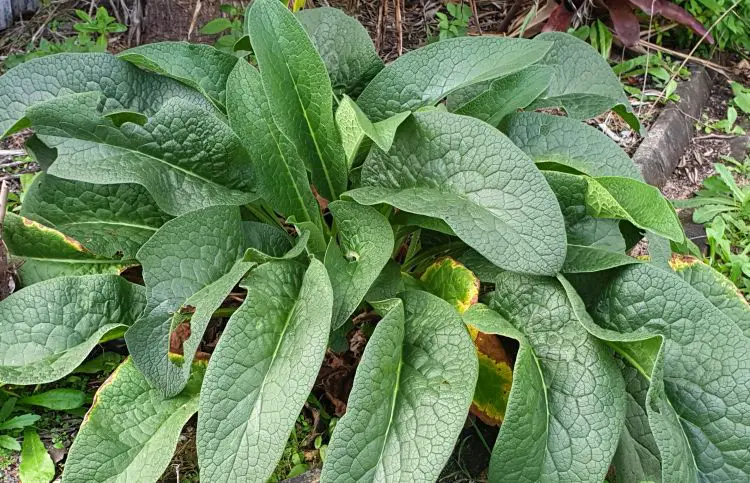Comfrey is an herbaceous perennial herb originating in Europe. A fast-growing plant belonging to the borage family, comfrey doesn’t provide fruit yet has the widest range of uses in a permaculture system of any plant. If you’re aiming to take steps towards self-sufficiency, this is a must-have plant in your garden system.

How Do I Use Comfrey?
Comfrey can be used as a mulch, fertiliser, compost accelerator, pollinator attractor, & clay soil breaker.
It is known to be one of the best ‘dynamic accumulator’ plants. These are plants which are able to help cycle nutrients throughout the soil and back to other plants. They do this by drawing up nutrients such as silica, nitrogen, magnesium, calcium, potassium and iron from deep within the soil via their long taproot. They then store those compounds in their leaves, which can be harvested and used for the benefit of other plants, usually via a home-made liquid fertiliser.
But comfrey leaves can be used as a fertiliser in more ways than one. You can cut and spread them over garden beds and around fruit trees like mulch & leave them to decompose on the spot. When used this way they will slowly help condition the soil. Make sure to only use the young leaves and not any part of the stem, as comfrey takes root easily.

Comfrey leaves are a beneficial addition to compost piles, too. They have an NPK ratio of 3-1-5, so the nitrogen in the leaves will add nutrition and speed up the composting process. Don’t add too much at once though, or you’ll upset the carbon-to-nitrogen ratio in your compost pile. It is said to improve a crop of potatoes; cut & place young comfrey leaves under your seed potatoes while planting for an increased yield.
You can make a liquid fertiliser from comfrey by soaking the leaves in water. Place something heavy like a rock on the leaves to keep them submerged, and wait until you have a smelly dark liquid- this will take a week or two. This liquid is a strong fertiliser which needs to be diluted with water before use.
Livestock and chicken feed can be supplemented with comfrey leaves. The high calcium content is good for egg producers, although they may not find comfrey as palatable as lettuce!

How Do I Grow Comfrey?
Comfrey is a hardy plant that will grow in a variety of climate zones. It really takes no effort from you at all, and will grow just as well in the subtropics as in cool temperate areas. It has large leaves which are somewhat prickly to the touch, and can grow up to 1m (3 feet) high. Comfrey makes an excellent border plant and can be planted close together in rows as a weed barrier.
Plant comfrey in spring in cool areas and during the wet season if you’re in a warm or tropical climate. It can generally be positioned in full sun but will benefit from some shade in hot tropical summers. While it is drought-tolerant once established, it will produce wonderful lush growth if kept in a moist soil. This plant can handle poor soil and will eventually fertilise itself via the leaves it has dropped. You can give it a nutrition boost with a liquid fertiliser at any time. As with any ‘leafy green’, a fertiliser high in nitrogen will work best.
Comfrey doesn’t always flower in subtropical and tropical areas as there may not be sufficient winter chill to induce flowering. I live in subtropical south-east Queensland, and my comfrey flowers then just powers on! In cold areas it will die back naturally after flowering and go dormant in winter. You can cut back and prune your comfrey to stimulate more growth at almost any time.

Growing comfrey from seed is notoriously tricky, so it is usually grown from root cuttings. All you need to do is take a 3cm (1.5″) section of a root and put it in a pot of soil. Keep the soil moist and you should see a comfrey plant appear within a week or two. Once you have a comfrey plant that’s been established for a year or two, you can dig up a section with a pitchfork, use the leaves elsewhere in the garden and split the root into pieces for propagation.
Comfrey takes root very easily, so choose its position carefully. Any root disturbance or breakage during transplant can generate new plants that you may not want.
Comfrey Cautions
Comfrey is an ancient herb which is known to have been cultivated for at least 2500 years. Its medicinal and healing properties have been recognised for centuries, to the extent that it was called ‘knitbone’ during the medieval period. Both the leaves and the root of the comfrey plant have more recently been shown to contain allantoin, mucilaginous particles, rosmarinic acid and other acid derivatives as active constituents. The prescribed external use of comfrey in medical treatments is indicated for a range of conditions including arthritis, strains, contusions, thrombosis and haematoma.
But a word of caution! While comfrey has a range of medicinal benefits, it is not recommended for internal use. You may have heard that you can drink a tea made from comfrey leaves, and this is something that was certainly done historically. We now know that comfrey contains pyrrolizidine alkaloids, which are present as an insect repellant but are toxic to the human liver. So save the comfrey tea for your plants, they will benefit from it more than you.
Now you know how easy it is, why not go ahead and grow some comfrey?! Your garden will thank you for it!












